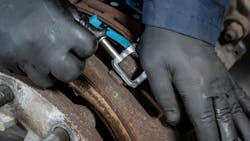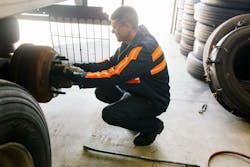Tools and techniques to streamline brake repairs
This is Part Two of a two-part story. To read Part One, click here.
Having the right tools to perform brake maintenance on commercial vehicles is crucial for technicians, according to 2023 TMC Super-Tech Grand Champion Doug Nickles. The FedEx Freight tech recommended that shops should have basic tools, such as jacks and jackstands, flashlights, snap ring pliers, and precision tools like dial indicators, mics, and wear gauges.
“Proper measuring tools and a clean, well-organized shop allow technicians to efficiently service brakes on trucks and trailers,” said Eric Daniels, VP of truck care for Love’s Travel Stops. “Additionally, when we’re working on dropped trailers at Love’s facilities, an integrated trailer tester such as the IPA Tools Alpha MUTT allows full remote operation of the braking system along with ABS diagnostics.”
Richard LaFlamme, technical services manager, SAF-Holland Inc., concurred on the importance of keeping shops neat and organized, adding that “lifts and pits make work easier as well.” He also recommended using tools that are specifically designed for the task. For example, the “5081” air brake spring tool is more efficient and safer than using a screwdriver to change brake shoes. “Correct tools always increase safety,” he said.
“Technicians must have proper equipment to lift and support vehicles,” said Brian Screeton, manager of technical service training, Bendix. “Lifting tools and/or dollies should also be used when removing tires and hub/rotor assemblies. Lastly, technicians will need shop air and a good set of air pressure gauges to perform pneumatic brake system diagnostics.”
Joe Kay, director of engineering at Cummins-Meritor, pointed out that there are brakes and lists of recommended tools in maintenance manuals for each brake type. An adequate weight jack for the truck that is being worked on, pry bars of different sizes, torque wrenches and sockets, brass drift, a set of screwdrivers, hammers, dial indicators for end-play checks, and calipers for other dimensional checks are among the standard items.
Read more: Product Showcase 2024: Brakes, Chassis, Steering & Suspension
At Cox Automotive, shop equipment for brake service is vehicle-dependent based on class or size, noted Larry Fowler, senior manager of vehicle operations support. When working on light-duty vehicles, for example, a two-post lift is adequate for lifting the vehicle safely. For medium- and heavy-duty trucks or trailers, a jack and jack stands are more time-efficient. In addition, to prevent injury when removing larger and heavier wheels on trucks and trailers, using a wheel dolly or pry bar to remove the wheels close to the ground is the recommended procedure.
Brake drums are very heavy, so brake drum caddies, handlers, and carts are good options for technician safety, Fowler added. There are also brake drum attachments that can be installed on a clutch jack to do the lifting for the technician. And don’t forget tools that make checking and measuring brake stroke easier, such as the OTC Tools – 5052 Slack Check Tool, and tools for checking brake lining thickness.
Utilizing Mitchell 1 software to prepare for a brake job is a useful way to see a visual diagram and ensure you have all necessary tools and parts before starting,” Fowler said. “The most important tool when finishing a brake service is a torque wrench for ensuring wheels are on correctly and to prevent premature wear to wheel studs and lug nuts, which can damage the wheel or cause a catastrophic failure.”
Preparation and training are vital
To prepare technicians, Screeton noted that quality technical education from a trusted source is essential. In addition to training, technicians should follow established safety precautions and refer to OEM service manuals for proper procedures.
Staying up to date with continuing education allows technicians to provide safe, accurate brake inspections and service, related Daniels.
Read more: Overachiever Awards: 'The Mentor' Dewey Bishop
“Technicians can ensure efficiency and accuracy by participating in routine training and by following policies and procedures according to maintenance manuals provided by manufacturers,” said LaFlamme.
Doing your homework is important, too, Nickles noted. “OEMs have manuals for their brake systems,” he stated. “Before attempting an inspection or repair, read the manuals to ensure you have a proper understanding of the system’s operation.”
Using the right parts
It is important to stick with a quality, name-brand manufacturer for any safety-critical parts, related Daniels. “At Love’s, we only use new brake components to ensure all parts are a direct replacement for OEM quality.”
“At Cox, we do recommend that OEM equivalent or better parts be used,” said Fowler.
Bendix recommends replacing “like for like” using the same parts the OEM used when the vehicle was manufactured, related Mark Holley, director of marketing and customer solutions - wheel end, Bendix. “Genuine OEM parts help maintain performance and the integrity of other brake system components,” he explained.
“Some components are designed to function optimally together, such as air disc brake pads and rotors, and when paired have longer service lives,” Holley continued. “If OEM parts are not an option, make sure the replacement parts selected are approved by the manufacturer.”
“OEM specs are always encouraged,” LaFlamme emphasized. “Reputable brands have established reliability and performance records and can provide superior after-sales support.”
Safety first with brake inspections, repairs
“The last thing any fleet, driver, or service provider wants to have happen is a failure on a major safety component that puts lives at risk if improper repairs are completed,” said Love’s Daniels.
For Cox Automotive, servicing brakes carries a significant responsibility, noted Fowler. “It’s imperative never to assume that everything is functioning correctly; for instance, by merely recording readings without conducting inspections,” he said. “Visual assessments serve as a proactive approach to identifying potential safety concerns.”
“Poor brake maintenance will lead to catastrophes that cannot be undone,” LaFlamme emphasized. “Preventive maintenance and standardized procedures ensure vehicles leave the shop in their best working condition so there is less risk.”
Truck operators should always make sure to address any brake concerns as soon as possible, related Kay. “One reason to assure maintenance practices are kept up is to ensure best stopping distances,” he explained.
“In addition to safety, proper brake service helps fleets maintain performance, minimize downtime, and help lower total cost of ownership,” said Holley. “It delivers peace of mind for fleets and drivers when they know they are properly maintaining their vehicles, and it helps keep roadways safe.”
Effective brake service begins with periodic, thorough brake inspections and proper troubleshooting. “It is critical for technicians to troubleshoot by first verifying the complaint or issue that’s been raised, then following the steps to determine the root cause,” Screeton said.
Fowler provides an example: Slack adjusters are not meant to be adjusted during every preventive maintenance inspection. If they do, it’s a clear indication that there may be underlying wear or damage preventing the adjuster from performing its intended function effectively.
About the Author

Seth Skydel
Seth Skydel, a veteran industry editor, has more than 36 years of experience in fleet management, trucking, and transportation and logistics publications. Today, in editorial and marketing roles, he writes about fleet, service, and transportation management, vehicle and information technology, and industry trends and issues.

